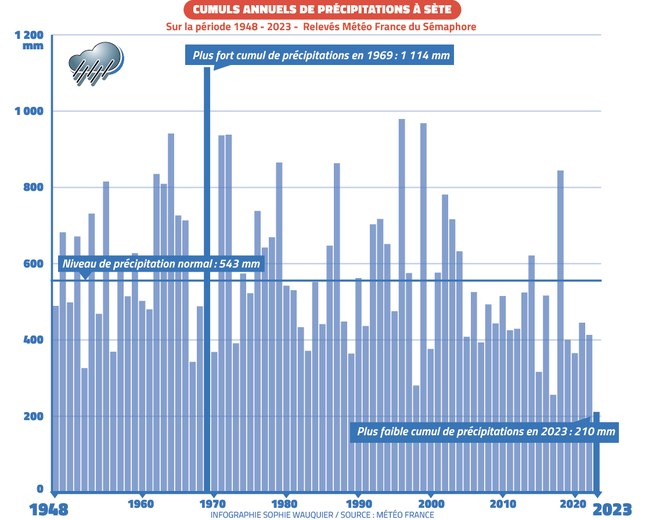Second hottest, driest year… the weather report in Sète in 2023

2023 a été l’année la plus sèche enregistrée à Sète. Midi Libre – EVA TISSOT
L’année dernière a été la plus chaude enregistrée dans le monde et la deuxième en France, derrière 2022. Qu’en a-t-il été à Sète ? Bilan avec Adrian Bourgois, météorologue à Météo France.
Do you have precise indicators regarding the weather in Sète in 2023 ?
Last year was the second warmest recorded in Sète by the Sémaphore station, located on the heights of Mont Saint-Clair, since records began in 1949. Average temperatures were summer 1.4 °C above normals, established in 1991 and 2020.
How can we explain this figure ?
First there is a long-term global warming trend, but there have also been high average temperatures within natural interannual fluctuations. Afterwards, we don't yet know all the parameters.
In summary, we are in for a hot year in a hot trend. With global warming, we must say that the hot years of today will become normal years, even cool, when the normals are updated in the future.
was 2023 a dry year like more generally in the region ?
Last year, it only rained 210 mm. 2023 was the driest year recorded in Sète. This is a record low rainfall since 1949, the normal being 543 mm. Since 2019, the annual cumulative precipitation has been below normal. For example, the cumulative precipitation from September to December 2023, the period when groundwater tables are supposed to recharge, was 57 mm when the normal is 257 mm. There was therefore a deficit of almost 80%. And this can have important consequences (see article below).

Total annual precipitation in Sète in 2023. Midi Libre – Sophie Wauquier
"19 mm of rain "maximum on one day in 2023, another record low rainfall"
What is this due to ?
In Sète, there is a Mediterranean climate. The latter is rather extreme, in the sense that there are often few rainy days, but the episodes are of high intensity. It is important to keep in mind that with this climate, the interannual variability of precipitation is naturally very high (more or less 50% compared to normal).
In the Mediterranean, cumulative rainfall can triple from one year to the next. For several months, the Massif Central and the Pyrenees, blocking humidity and drying out the territory, have deprived Sète and its surroundings of Mediterranean episodes and therefore of rain. The maximum precipitation in one day in 2023 was 19 mm. This is a record low rainfall over 24 hours.
Also read: Weather: 2023 was the driest year recorded in Sète, what consequences to expect in 2024 ?
In 2023, no negative temperatures and no days of frost have been recorded at Sémaphore. Is this worrying ?
Not necessarily. You should know that the Semaphore weather records are taken at an altitude of 75 m. Due to this height, the minimum temperatures recorded are often milder than if there had been a weather station in a field at sea level. It is likely that there were negative temperatures and frost in Sète, in places closer to sea level.
That said, we see that the fact that it does not freeze is not that common. Over 75 years of observation, there are only 14 years where there has been no frost, including seven in the last ten years. The last day of frost was January 11, 2021. We could potentially break the record for frost-free time, which stood for almost four years between 2013 and 2017. Due to global warming, frost is becoming less and less frequent.
What weather to expect at the end of winter ?
Forecast Since the start of the week, the people of Sétois have noticed a change in the weather. While the month of December was 1.7 °C above seasonal norms, namely 9.3 °C, the mild winter weather has given way to constant cold in recent days. The wind never stops blowing, with frequent gusts above 50 km/h. And the rain even made an impressive return. On Wednesday January 10 alone, 55.9 mm of water fell, or 27% of the precipitation recorded in 2023.
Will the weather in the coming days and weeks continue on this path ? "Currently, we have slightly cooler temperatures of 3 to 5 °C below seasonal norms,” emphasizes Adrian Bourgois. However, this trend is not expected to last according to the meteorologist: "Temperatures will rise above normal from next week". Overall, the seasonal trend for January-February-March is 'warm'. "In Sète, there is a 50% probability that we will end winter above seasonal norms, 30% that we will be around and 20% that we will be around 20%. we are below."
Concerning precipitation, "no scenario emerges for the coming quarter. We could stay with a rather disturbed westerly regime as we have known for two months." Finally, will we have negative temperatures ? "Difficult to say. Of course, it is possible to have a cool period, even if the three-month signal is hot." As they say, never say never.
Given the figures from recent years, how should the climate in Sète evolve in the decades to come ?
There is a clear trend towards global warming. In the south of France as in Sète, it has been more than 2 °C for 70 years, with shorter cold periods and longer hot periods and heatwaves. We also observe a downward trend in precipitation around the Mediterranean over the last 50 years. The projections therefore show drying out, especially in summer.
In a few decades, the climate of Sète could be closer to that of Valencia or Alicante in Spain, which is warmer by around 2 °C, drier and with an annual average precipitation of 400 to 450 mm. Seeing heat peaks at 44 °C would then not be shocking. We can therefore expect average and extreme heat records to be broken in the years to come.




